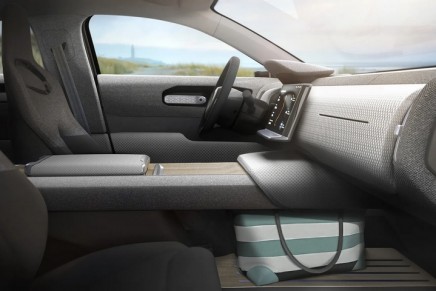
Lightyear One Car Prototype at Goodwood Festival of Speed 2019; @twitter.com/lightyear_cars
The Dutch solar-electric prototype generates some of the power it needs as it travels. Lightyear One charges itself whenever it absorbs daylight. Independence from charging stations means that you are free to roam the world.
Lightyear One highlights include a solar roof and hood, a low aerodynamic drag, and reduced weight.
The roof and hood of Lightyear One comprise of five square meters of integrated solar cells within safety glass so strong that “a fully grown adult can walk on them without causing dents.” As a result, Lightyear One charges itself whenever it absorbs daylight. The solar-powered vehicle has a remarkably low aerodynamic drag, with the best aerodynamic coefficient of any car on the market, said the automotive company founded in the Netherlands in 2016 by Lex Hoefsloot. This increases the range of the car by decreasing energy consumption.
“At the moment it is still a prototype, but prospective buyers can reserve one of 1,000 vehicles that are being built for release in 2021 – that privilege will cost you £3,600,” wrote theguardian.
The car’s engineers found the balance of using lighter building materials like aluminium and carbon fiber while maintaining rigorous safety standards. The result is a car that is less heavy, consumes less energy and has an exceptional range.
The efficiency of Lightyear One means that it’s possible to get more charging performance from any charging outlet in less time. Through fast charging, you can charge up to 570km worth of energy within an hour and with a simple 230V outlet, it’s even possible to charge up to 350km worth of energy overnight.
Unlike conventional solar panels, the car’s cells function independently. This means that even if part of the roof or hood is in shadow, the other cells continue to efficiently collect solar energy. “In fact, our solar cells provide about 20% more energy than traditional ones,” announced the car manufacturer, who charges €4.000 for reservations.
Lightyear One’s future owner can choose different options based on the different expected delivery dates. The full price of a Lightyear One is €149.000 including 21% VAT. If you want one of the first 100 cars, you’ll have to pay £107,000 in the U.K.
Up to 100% of your mileage
The solar roof and hood charge up to 12 km/h in the sun. Your climate and driving frequency will determine the percentage of your mileage this can give you. Someone driving the national average of 20,000 km/year in the cloudy Netherlands would get about 40% of their mileage from c.
Emergency range extension
Lightyear One has a solution to accidentally running out of battery. You can drive 15-20km/h on what the solar roof and hood absorb from daylight, getting you to an outlet with no roadside assistance required.

Lightyear One Car Prototype car showcased to friends and family at Lightyear production facility in Helmond (2019); @twitter.com/lightyear_cars









